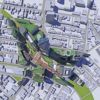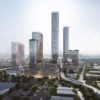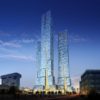The cranes have returned to the Garden State’s largest city.
Building cranes, that is. After a hiatus of several decades, construction cranes are beginning to dot the skyline of Newark, New Jersey—an important part of the revitalization of a city that was once the butt of jokes by late-night comedians but which is becoming an example of how a municipality can reinvent itself.
Thanks to an inspirational active mayor, a vision to make Newark a model of urban transformation, a great location, strong civic boosters, and the wherewithal to follow through on projects that once would be mired in red tape for years, New Jersey’s biggest municipality is experiencing an urban renaissance.
“Newark’s freefall has stopped,” says Robert Antonicello, executive director of the Jersey City Redevelopment Agency and chair of ULI New Jersey. “The fortunes of the city are rising thanks to Mayor Cory Booker, who put professional management in place and who has tirelessly promoted the city. It all starts by having a squeaky-clean administration. People won’t invest if they don’t believe a city’s leadership has a vision, is honest, and is committed to change.”
 Tucker Development of Chicago is building a 150-room Courtyard by Marriott downtown. |
Helping spur Newark’s revitalization was construction of the $375 million Prudential Center, which hosts the National Hockey League’s New Jersey Devils, the National Basketball Association’s New Jersey Nets, Seton Hall Men’s Basketball, and others. Prudential Center is viewed as the cornerstone of downtown Newark’s renaissance, which includes condominiums, restaurants, themed bars, and retail establishments as well as the New Jersey Performing Arts Center, one of the ten largest performing arts venues in the United States.
“In Newark this year, we have dozens of ongoing projects that total over $700 million of investment and will create more than 2,500 permanent jobs,” says Newark Deputy Mayor Adam Zipkin. “Development is spread through all of our neighborhoods and in the port area, where new manufacturing facilities and distribution centers are bringing jobs to the city. Newark’s downtown is being transformed, creating a vibrant 24/7 downtown for visitors and residents.”
Lyneir Richardson, chief executive officer of Brick City Development Corporation, Newark’s economic development corporation, recalls that when he started two and a half years ago, the city had 40 projects in the pipeline. “Mayor Booker created initiatives to move those projects to the finish line and concentrated on what could get started within 12 to 18 months,” he explains. “2011 was our ground-breaking year, with over $700 million under construction including two hotels—the first new hotels downtown in over 40 years. Now we have seven sites suitable for office towers. It’s so gratifying to see cranes in the sky again.”
Companies are rediscovering the advantages of Newark, Richardson adds. “We have an international airport and the country’s third-largest seaport. Six major highways pass through the city. We are 21 minutes from New York City and we have terrific mass transit,” he notes. “Newark is also a college town. There are six colleges and universities, with over 40,000 students within a ten-minute walk of downtown.”
One of the biggest developments in the central business district (CBD) was Panasonic’s decision to build its new North American headquarters in downtown. Scheduled to be completed in 2013, the 340,000-square-foot (31,586-sq-m) structure is a joint venture of Cranbury, New Jersey–based Matrix Development Group and SJP Properties of Parsippany, New Jersey. Under the deal, Panasonic will relocate 1,000 employees from its current Secaucus, New Jersey, headquarters to Matrix’s Two Riverfront Center adjacent to Newark Penn Station and the Gateway Center business complex. The Japanese electronics giant was lured by Urban Transit Hub Tax Credits and other incentives designed to locate businesses near major public transit centers.
Says Richard F.X. Johnson, senior vice president of Matrix: “Panasonic will be occupying the majority of a new LEED-certified, 12-story Class A office building and will be part of Matrix Riverfront Center. Panasonic’s relocation from a suburban location to an urban transit-oriented site—they expect 80 percent of their employees to use mass transit—is consistent with the company’s sustainability initiatives.”
Johnson adds that as in any urban development project, building construction costs—as well as the capital costs of parking structures—pose some challenges. “However, the economic development programs crafted by the state of New Jersey and fully supported by the [Governor Chris] Christie administration, coupled with those initiated by the city of Newark, help developers meet these challenges and produce investment-grade projects,” he says.
Commercial developments like Panasonic are generating additional residential development downtown. “We expect that residential and retail will follow commercial,” says Brick City’s Richardson. Now we have 800 residential units downtown, over 700 in the development process, and another 800 on the planning table. At some point, we will be getting to the tipping point with enough downtown residents combining with entertainment and office to create a 24/7 downtown. Urban development is evolutionary, not revolutionary. Every day we are kicking the ball down the field, one yard at a time. We’re hungry for credible development projects. This administration wants to get deals done and we’re looking for anyone with a good idea and investment capital to come join us to make it happen.”
George H. Jacobs, president of Clifton, New Jersey–based Jacobs Enterprises, Inc., a development, consulting, management, and brokerage company focused on the retail and multifamily residential sectors, also credits the mayor and the new staff at city hall for starting—and following through on—Newark’s rebirth. “Mayor Booker was a breath of fresh air,” Jacobs says. “He brought in young, talented people and invigorated new investments. The two most significant catalytic events were the construction of the Performing Arts Center and Prudential Arena. Now we’re looking to projects such as Teachers Village.”
RBH Group, Jacobs Enterprises, and others are developing Teachers Village, which will eventually feature three charter schools with 1,000 students and 221 residential units marketed to educators. The first phase of the $120 million project broke ground in February, with the construction of eight low-rise mixed-use buildings spanning five blocks.
In addition, Tucker Development of Chicago is building a 150-room Courtyard by Marriott downtown. The Hanini Group, based in Newark, is developing the 106-room, 12-story Indigo Hotel, which will be built on the site of the 99-year-old First National State Bank building and share a block with the Prudential Center. Dranoff Properties of Philadelphia is planning a $190 million high rise of 328 luxury apartments and 20,000 square feet (1,858 sq m) of retail space.
“Right now, they are planting all seeds that will bloom and we’ll reap a great harvest,” says Antonicello. “Newark’s school system is getting a makeover thanks to a $100 million donation by Facebook founder Mark Zuckerberg. Insurance giant Prudential has been a cornerstone of Newark for decades and is looking for a new corporate headquarters in the city. Prudential has been here in the good times and the bad times. It’s a terrific corporate citizen.”
Newark officials are working hard to attract new businesses, new development, and new jobs, says Richardson. “Newark needs developers who have been successful, diligent, persistent, organized, and committed,” he continues. “It’s not just understanding site control and real estate value. It’s about wanting to join a movement to revitalize an American city.”
Says Deputy Mayor Zipkin: “Companies and individuals are continuing to rediscover the joy of urban life and the benefits of the unmatched transportation and infrastructure that a city like Newark can offer.”
Those interested in developing in Newark should do the following:
- Open their eyes to future possibilities, not past problems, says Antonicello. “You have to envision where the city will be in five years, not where it’s been in the past 20. The future of this state is really urban and where Newark goes, so goes the state. And where every city is going, Newark will get there first.”
- “Present a solid development idea combined with equity capital,” says Richardson. “We will jump behind and support any credible development that has capital and developers able to execute their vision. There is opportunity for new office and residential developers in Newark’s CBD. We are the next city on the East Coast that has real opportunity for growth and gentrification.”
- Be prepared to make not only an economic investment in Newark, but also a strong emotional commitment, says Jacobs. “It’s not only about building a new building, but about engaging the city. Newark officials want to be a partner and they are willing to go the extra mile for you if you are committed to doing what you promise.”?








